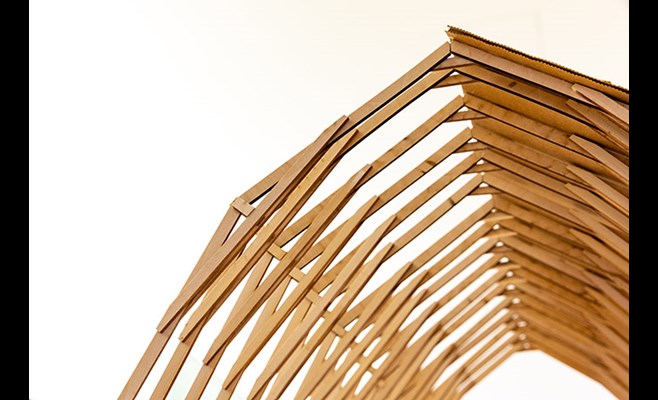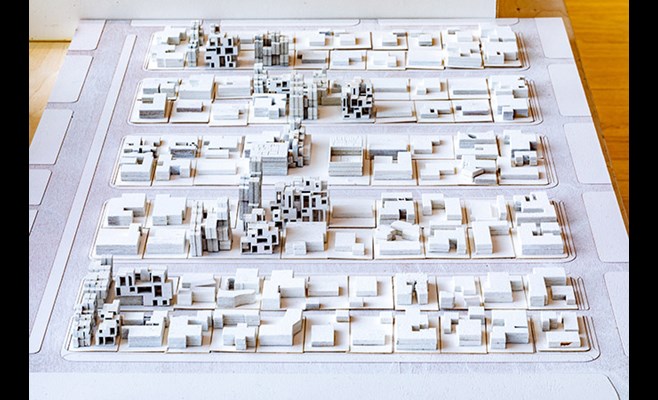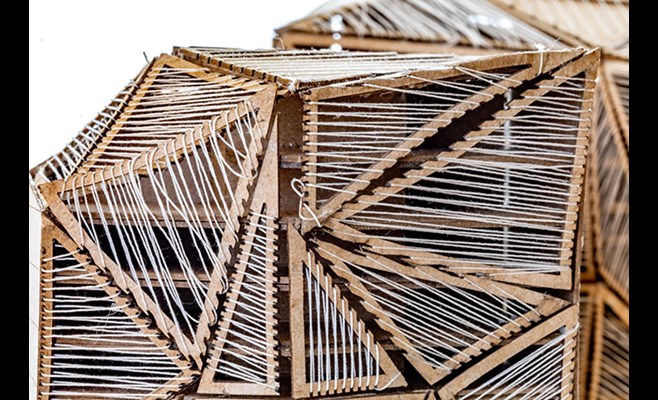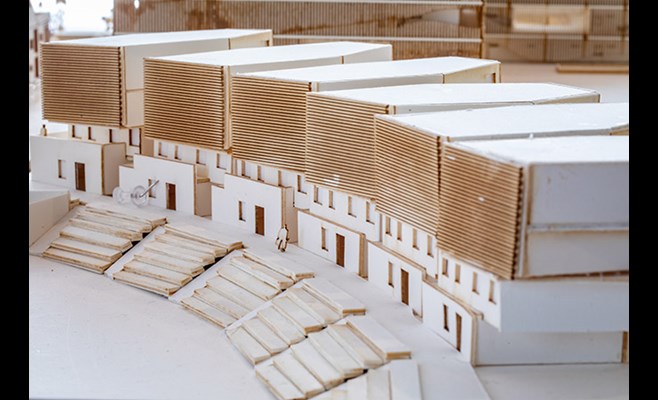Fay Jones School's Architecture Program Receives Eight-Year Reaccreditation From National Board

Design work by architecture students in the Fay Jones School of Architecture and Design was on display in Vol Walker Hall in spring 2023 as part of the architecture program's reaccreditation process.
The professional Bachelor of Architecture program in the Fay Jones School of Architecture and Design recently was granted an eight-year term of reaccreditation by the National Architectural Accrediting Board.
"The University of Arkansas' Fay Jones School of Architecture and Design is clearly a significant asset to not only the state of Arkansas but the architecture community as a whole," stated the visiting team in its summary. "During our visit, the team was able to meet with many of the program's students, faculty and staff, and gained a great appreciation for the efforts that have gone into creating a well-rounded and versed architectural education. It was well received that the program offers a strong focus on preparing its students for the post-graduate experience and entering the workforce.
"The program and college's commitment to improving the equity, diversity and inclusion of the program … was appreciated," the visiting team stated. "In addition, the program's focus on environmental sustainability, particularly its focus on local and regional materials and issues such as mass timber, are commendable."
On Nov. 4, the National Architectural Accrediting Board met to review the Visiting Team Report, the product of a five-member team's virtual visit with Fay Jones School leadership in March. The directors of the National Architectural Accrediting Board voted to continue full accreditation for the maximum term of eight years. The Fay Jones School architecture program is scheduled for its next accreditation visit in 2031.
"A full eight-year term of reaccreditation from the NAAB is validation of the ongoing strength of the degree program in the Department of Architecture," said Peter MacKeith, dean of the Fay Jones School, "but moreover of the contemporary vitality and quality of the department's curriculum, faculty and students. We are privileged as a school to possess three superb departments — architecture, landscape architecture and interior architecture — each preparing students through their accredited programs for careers of professional accomplishment.
"On behalf of the school, I want to thank Professor John Folan, AIA, head of the department, for his leadership, stamina and insight as he organized the department for the review, and to thank the faculty in architecture for their many contributions to the process over the last two years. Well done, and congratulations to the department!"
The National Architectural Accrediting Board is the only agency recognized by registration boards in U.S. jurisdictions to accredit professional degree programs in architecture. Since most state registration boards in the country require any applicant for licensure to have graduated from a NAAB-accredited program, obtaining such a degree is an essential aspect of preparing for the professional practice of architecture. There are currently 175 NAAB-accredited programs offered by 139 institutions of higher learning in the U.S. and abroad.
After completing internships with a licensed professional, graduates must pass the Architecture Registration Exam. Graduates of the architecture program have a wide array of career opportunities, such as designing new buildings, preserving historic buildings, participating in urban design, managing construction projects or writing about architecture.
"The reaccreditation process is first and foremost an external review of the program. That external evaluation is of critical importance, as it establishes the academic and professional relevance of what is being pursued by students, faculty and staff," said John Folan, professor and head of the Department of Architecture. "The process also provides a unique opportunity for self-reflection; it allows the department to understand what it does well, the positive impact that it has on so many, and identify what opportunities lay ahead in a rapidly evolving cultural context. The totality of material exhibited for the NAAB reaccreditation team and board represents a group of thoughtful, curious, talented students led by an empathetic, discerning and accomplished faculty who are concerned with creating a positive future for all. Preparations for the NAAB visit illuminated those sensibilities and characteristics, which were recognized by the visiting team."
The accreditation process asked the school to demonstrate individual strengths of its programs, but also the strengths of architecture education and professional preparation. This process included a self-study, peer review, a report prepared by the visiting team, action in the form of a judgment by the NAAB Board and ongoing external review.
"I have participated in more than 20 NAAB accreditation visits, both as a faculty member and as a NAAB visiting team member," said Ethel Goodstein-Murphree, associate dean and professor of architecture. "Regardless of which side of the table I occupy, the constant and purposeful evolution of accreditation criteria and assessment methods is a potent reminder that the body of knowledge we are obliged to offer our students is ever-changing. While we always have abided by the fundamental tenet of accreditation — to prepare our students to attain professional licensure in architecture — the current ethos of the NAAB affords schools the opportunity to forge their identities by cultivating areas of excellence and articulating core values for their programs. Environmental stewardship, social equity in the made environment and emerging technologies for design thinking all figure in the work of today's architect. With that in mind, our accreditation not only looks back at the last eight years, its evaluation of the accomplishments of our students and faculty also creates a sense of measurement from which we can look forward."
The architecture program is required to submit an Annual Statistical Report and an Interim Progress Report two years and five years after the team's visit. All documents related to the accreditation process are publicly available on the Fay Jones School website.
Topics
Contacts
Michelle Parks, director of communications
Fay Jones School of Architecture and Design
479-575-4704,
mparks17@uark.edu
Headlines
Four Students Named Goldwater Scholars; Two Earn Udall Honorable Mentions
Four U of A students have received the prestigious Goldwater Scholarship, an award for top students in mathematics, science, and engineering.
Cross-Campus Collaboration Culminates in New Outdoor Geological Installation
Grand opening event to celebrate the new GeoLab installation at the U of A’s Gearhart Hall courtyard is set for May 3. The installation will be open to the public year-round.
First Students to Use Online Degree to Hone Nursing Leadership, Elevate Patient Care
Hanna Baxendale and Wendi Kimbrell will begin coursework in the Doctor of Nursing Practice-Executive Master of Business Administration program offered by the Eleanor Mann School of Nursing and Walton College.
Join the Office for Sustainability on a Final Cruise to Campus
Cruise to Campus Wednesdays have fostered a gathering space for individuals interested in biking to campus. Drop by the Old Main Lawn from 7:30-10 a.m. Wednesday for coffee, something to eat and conversation.
Fay Jones School Student Ambassador Program Gives Voice to Design Students
The student ambassador program at the Fay Jones School of Architecture and Design is built to connect top design students with their school, its alumni, its future students and others inside and outside the school.















